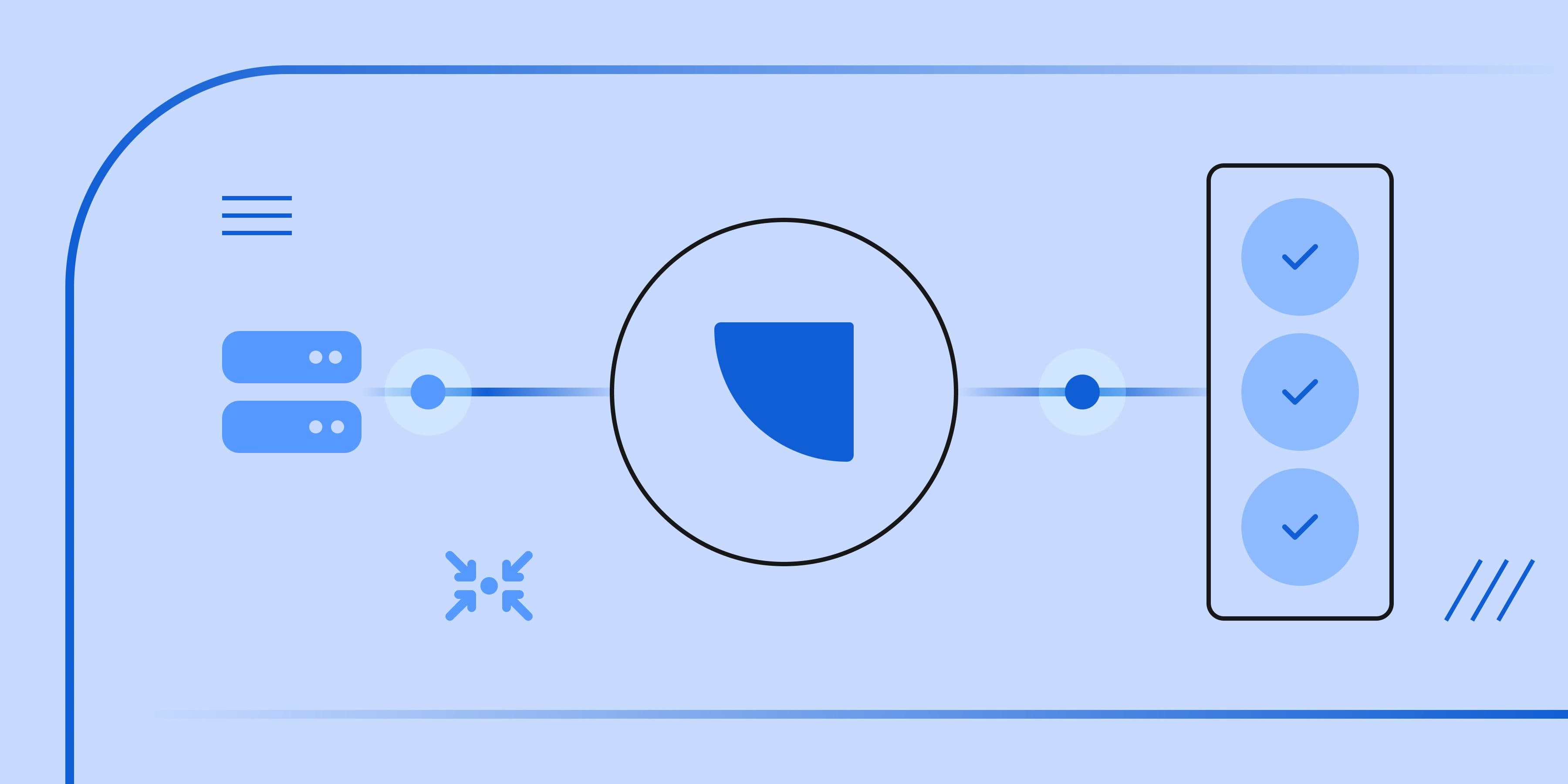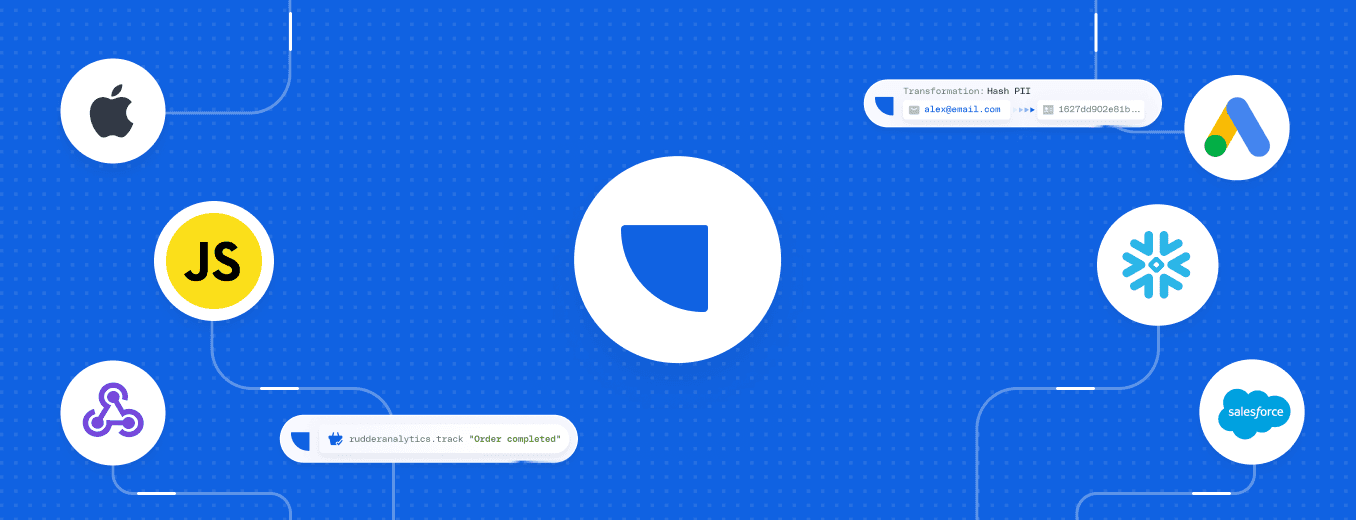What is user segmentation? Definition, examples, and benefits

User segmentation is crucial for creating effective marketing strategies that delight your ideal customer profile (ICP).
By grouping customers based on shared characteristics, such as company size, user behavior, or firmographic information, marketers can tailor product experiences, messaging, and marketing campaigns, sales teams can identify new prospecting opportunities, and businesses can ultimately increase revenue.
In this article, we’ll look at the importance of user segmentation, different segmentation types, specific examples of user segmentation, and how you can implement it in your business with the RudderStack Warehouse Native customer data platform.
What is user segmentation?
User segmentation divides a company's target audience into distinct groups based on shared characteristics, behaviors, or demographics. Through this process, businesses gain a stronger understanding of their audiences.
User segmentation models are critical to product management and marketing, especially in the ecommerce and SaaS sectors. By tailoring marketing efforts to the specific needs of individual users or groups, companies can increase engagement, enhance customer satisfaction, and, ultimately, drive more sales.
User segments can be designed around demography, behavior, technographics, or geography. Factors like firmographics and psychographic customer data can also be used.
Why segmentation is essential
Segmentation helps streamline marketing and sales campaigns. With user segmentation, businesses can:
Tailor marketing
User segmentation allows businesses to customize and personalize their marketing efforts. This makes campaigns more likely to resonate with audiences and, as a result, drive conversions.
Combining customer history with demographic and technographic data can also strengthen personalization and improve customer experience.
Guide product development
The best businesses are always refining their products and/or services. This process works best when supported by customer insights.
User segmentation makes it easier to discern the needs and preferences of specific customer types. This information enables further innovation and ensures that the development process is customer-centric.
Enhance the onboarding experience
The first experience a customer has of your product or service is vitally important. User segmentation can enhance the onboarding experience by helping you figure out what each type of customer needs to have a smooth introduction to your product.
Whether this involves making tweaks to the terminology you use or altering the steps you ask new customers to follow, personalizing the onboarding process by segment can reduce drop-off rates and increase satisfaction.
Eight types of user segmentation
Businesses can choose to segment their user base in practically any way, but some methods are more useful than others. Here are eight commonly used methods of user segmentation:
- Demographic segmentation: Dividing users based on demographic factors, such as age, gender, income, education, or marital status.
- Geographic segmentation: Categorizing customers based on geographical location, such as country, region, city, or climate.
- Psychographic segmentation: Classifying users based on their lifestyles, interests, values, and personality traits.
- Behavioral segmentation: Grouping users according to their behaviors, usage patterns, product preferences, and brand loyalty.
- Technographic segmentation: Categorizing clients based on the technology and tools they use, such as software, devices, or platforms. This is more commonly used in B2B contexts.
- Firmographic segmentation: Classifying users based on company characteristics, such as industry, company size, or revenue. This method is also more common in B2B use cases.
- Customer journey stage segmentation: Grouping customers based on where they are in their customer journey, such as awareness, consideration, or conversion stages.
- Usage frequency segmentation: Dividing users based on the frequency or intensity of their service or product usage.
User segmentation examples
The user segmentation process is used across most industries. Here are some use cases that illustrate its applications.
E-commerce excellence: Personalized shopping at Amazon
Amazon's mastery of user segmentation transforms the online shopping experience. By analyzing customers’ past purchase histories, preferred styles, and product searches, Amazon can suggest the most relevant products for future purchases. This significantly boosts the likelihood of conversions and enhances overall customer satisfaction.
Tailoring the experience: In-app personalization by Netflix and Spotify
By diving deep into user behaviors, such as listening habits, favorite genres, or viewing histories, platforms like Netflix and Spotify can create custom playlists and content recommendations. This personalized approach provides users with unique and enjoyable new music and video experiences.
Revolutionizing rewards: Uber and Starbucks success stories
Uber sends targeted discounts and promotions to specific user segments based on factors such as ride history, location patterns, and usage frequency. This incentivizes continued use of the platform.
Starbucks employs user segmentation in its loyalty program in a similar way. By analyzing purchase histories and visiting metrics, the company can identify preferences and offer customers personalized rewards, discounts, and promotions.
Precision in advertising: Personalized ad targeting on Facebook
Facebook's personalized ad targeting goes beyond traditional advertising strategies by tailoring content to individual users. After analyzing user demographics, interests, and online behaviors, Facebook tailors its advertisements to match each individual’s preferences, ensuring users see content that resonates with their unique interests.
How to approach user segmentation
Here are our top tips for using user segmentation effectively.
Determine your goals
Before starting any other part of user segmentation, you must outline your objectives. Segmenting your customers haphazardly is of no use. A clear understanding of the reasons behind segmentation and what you want to achieve are essential for informed decisions.
Developing a strong strategy for customer segmentation is also important. This will ensure everyone thoroughly understands your approach and will help you to analyze your results following the implementation of user segmentation.
Finally, make sure to fully document your decisions, as this will make it easier to get new hires up to speed in the future.
Gather relevant data
The next step is to gather the necessary data. This will include any data points that provide the insights you want into your audience, such as demographic information, user behaviors, purchase history and preferences, or firmographics.
Focus on what your users want or need from your product or service, as exceeding expectations is the biggest driver of customer lifetime value. Hone in on factors such as budget limitations and user interface preferences.
Finding relevant reviews or testimonials left by your audience about other brands can shed light on what actions they respond positively to—and what corporate mistakes can push them away.
Keep in mind that this data collection and analysis shouldn’t be limited to the initial collection tool. Many businesses are adopting the composable customer data platform (cCDP) strategy for data management.
A cCDP enables the transfer of data from diverse data repositories into a data cloud, such as Snowflake. The data undergoes transformation and purification to ensure it is in a state that can be effectively utilized.
Analyze segmented data
Once you have your data, use data analysis tools and techniques to identify the patterns and relationships within it. This analysis will help you identify natural groupings and segments that share common characteristics.
If you’re unsure which segments to prioritize, think ahead to the marketing tactics you might wish to use. A segment that might seem very promising but would require you to compete in areas of marketing that are not your strongest will not be the best target in the long run.
However, don’t abandon segments that might seem challenging too quickly. Great marketing is creative and ever-changing, and those qualities are far easier to achieve when marketers are interested in the work they’re doing.
Create user personas
After completing data analysis, develop user personas. Personas are fictional characters representing different segments of your audience. They help humanize your target audience and guide decision-making based on specific user characteristics.
Personas are essential for tailoring information and services for your customer base while maintaining data privacy. How specific you get with your personas, whether you give them names and expansive backgrounds or just stick to the basic details, depends on what best suits your business needs.
Implement segmentation across platforms
Now you can implement your segmentation strategy across relevant platforms and channels. This could include your website, email marketing, social media, and other customer touchpoints.
Tailor your marketing campaigns and create personalized content, targeted promotions, and communication strategies that resonate with the characteristics of each identified segment.
If you lack confidence with certain channels and feel reluctant to get started, spend some time researching the tactics of your competitors and other companies within your broader industry. Look at their best-performing ads and pieces of marketing content to determine which audiences they’re targeting and why they’re using those methods.
Monitor and adjust
Lastly, monitor the performance of your segmentation strategy. Track key performance indicators (KPIs) and conduct A/B testing to refine your approach.
Study behavioral analytics to see how your customers interact with your products and services and make adjustments as needed. User behavior and preferences may evolve, so make sure your segmentation strategy is adaptable.
If there’s a great deal of variety in what your customers require, you may also benefit from trying to identify your most avid users (you could consider them power users) through behavioral segmentation.
Because power users and casual users have different needs and tendencies, they’ll also have different insights—and if you intend to improve your value proposition, you’ll need to keep both perspectives in mind.
Optimize your marketing strategy with user segmentation
With user segmentation, businesses can deliver personalized and relevant customer experiences, ultimately driving better engagement and satisfaction.
RudderStack provides a powerful warehouse native customer data platform that supports every stage of the data activation journey. Combine customer data from multiple sources on a single, secure platform and build a true customer 360 with the RudderStack Identity Resolution Toolkit.
Find out more about how RudderStack can turn your customer data into a competitive advantage today.
FAQs about user segmentation
Can you combine different types of user segmentations?
Yes. Combining different user segments provides deeper customer insights, which enables more precise targeting. For example, combining geographic and demographic information could reveal an audience with a shared interest in a specific location. This could be used to target event invitations.
What are the best practices for effective user segmentation?
Effective user segmentation transforms marketing strategies. Here are some top user segmentation process best practices:
- Update and validate segments regularly to ensure continued accuracy
- Use data-driven approaches and always avoid assumptions
- Keep segments actionable and meaningful for relevant marketing strategies
- Test marketing strategies for each segment and refine them for effectiveness
- Ensure compliance with data privacy regulations to avoid penalties
How does user segmentation differ across industries?
Different industries will choose segmentation criteria based on their specific needs. For example, an e-commerce company might focus more on purchasing behaviors, healthcare providers may prioritize demographic and health-related data, and B2B businesses often focus on firmographics.
Recent Posts
 Event Streaming: What It Is, How It Works, and Why You Should Use It
Event Streaming: What It Is, How It Works, and Why You Should Use It Data governance for healthcare: How regulated industries build trust at scale
Data governance for healthcare: How regulated industries build trust at scale RudderStack Transformations: Unlocking advanced data engineering use cases
RudderStack Transformations: Unlocking advanced data engineering use cases